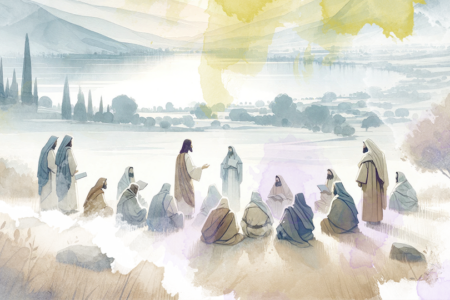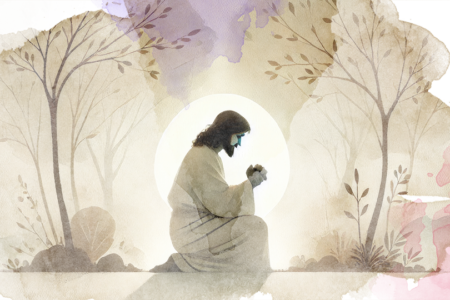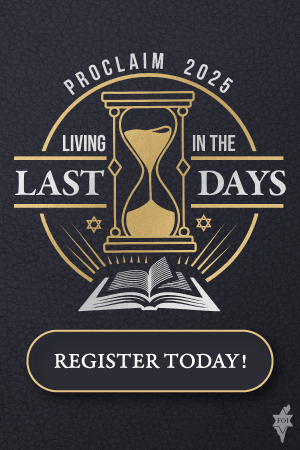Behold, The Bridegroom Comes
The Comforting Promise
It was a night of destiny. Jesus had gathered with His disciples in the Upper Room. In a few more hours He would be crucified on a cross.
Jesus had been warning His disciples concerning His coming death, resurrection and ascension to heaven. The prospect of these events caused the disciples to be greatly disturbed. In order to ease their fears, Jesus made the following comforting promise:
Let not your heart be troubled: you believe in God, believe also in me. In my Father’s house are many mansions: if it were not so. I would have told you. I go to prepare a place for you. And if I go and prepare a place for you, I will come again, and receive you unto myself; that where I am, there you may be also (KJV, John 14:1-3).
Jewish Marriage Customs
Those who live in the modern western world do not catch the full significance of Jesus’ promise. This is due to the fact that in His promise Jesus was drawing an analogy from Jewish marriage customs in biblical times, Since this is so, those marriage customs must be examined if one is to grasp the significance of the promise.
The first major step in a Jewish marriage was betrothal.1 Betrothal involved the establishment of a marriage covenant. By Jesus’ time it was usual for such a covenant to be established as the result of the prospective bridegroom taking the initiative.2 The prospective bridegroom would travel from his father’s house to the home of the prospective bride. There he would negotiate with the father of the young woman to determine the price (mohar) that he must pay to purchase his bride.3 Once the bridegroom paid the purchase price, the marriage covenant was thereby established, and the young man and woman were regarded to be husband and wife.4 From that moment on the bride was declared to be consecrated or sanctified, set apart exclusively for her bridegroom.5 As a symbol of the covenant relationship that had been established, the groom and bride would drink from a cup of wine over which a betrothal benediction had been pronounced.6
After the marriage covenant had been established, the groom would leave the home of the bride and return to his father’s house. There he would remain separate from his bride for a period of twelve months.7 This period of separation afforded the bride time to gather her trousseau and to prepare for married life. The groom occupied himself with the preparation of living accommodations at his father’s house to which he could bring his bride.
At the end of the period of separation the groom would come to take his bride to live with him. The taking of the bride usually took place at night. The groom, best man and other male escorts would leave the groom’s father’s house and conduct a torch light procession to the home of the bride.9 Although the bride was expecting her groom to come for her, she did not know the exact time of his coming.10 As a result the groom’s arrival would be preceded by a shout.11 This shout would forewarn the bride to be prepared for the coming of the groom.
After the groom received his bride together with her female attendants, the enlarged wedding party would return from the bride’s home to the groom’s father’s house.12 Upon arrival there the wedding party would find that the wedding guests had assembled already.
Shortly after arrival the bride and groom would be escorted by the other members of the wedding party to the bridal chamber (huppah). Prior to entering the chamber the bride remained veiled so that no one could see her face.13 While the groomsmen and bridesmaids would wait outside, the bride and groom would enter the bridal chamber as one. There in the privacy of that place they would, enter into physical union for the first time, thereby consummating the marriage that had been covenanted earlier.14
After the marriage was consummated, the groom would announce the consummation to the other members of the wedding party waiting outside the chamber (John 3:29). These people would pass on the news of the marital union to the wedding guests.15 Upon receiving this good news the wedding guests would feast and make merry for the next seven days.16
During the seven days of the wedding festivities, which were sometimes called “’the seven days of the huppah, ” the bride remained hidden in the bridal chamber.17 At the conclusion of these seven days the groom would bring his bride out of the bridal chamber, now with her veil removed, so that all could see who his bride was.
The Examination of the Analogy
Earlier it was stated that in His promise in John 14 Jesus drew an analogy from Jewish marriage customs in biblical times. Now that the marriage customs have been considered, it is essential that the analogy be examined. In what ways was Jesus’ promise analogous with Jewish marriage customs?
In the examination of the analogy the first thing that should be noted is the fact that the Scriptures regard the Church to be the Bride of Christ (Eph. 5:22-33). In addition, just as the Jewish bridegroom took the initiative in marriage by leaving his father’s house and traveling to the home of the prospective bride, so Jesus left his Father’s house in heaven and travelled to earth, the home of His prospective Church, over 1900 years ago.
In the same manner as the Jewish bridegroom came to the bride’s home for the purpose of obtaining her through the establishment of a marriage covenant, so Jesus came to earth for the purpose of obtaining the Church through the establishment of a covenant. On the same night in which Jesus made His promise in John 14 He instituted communion. As He passed the cup of wine to His disciples. He said: “This cup is the new covenant in my blood” (NASV, I Cor. 11:25).
This was His way of saying that He would establish a new covenant through the shedding of His blood on the cross.
Parallel to the custom of the Jewish groom paying a price to purchase his bride, Jesus paid a price to purchase His Bride, the Church. The price that He paid was His own life blood. It was because of this purchase price that Paul wrote the following to members of the Church: “do you not know .. that you are not your own? For you have been bought with a price; therefore glorify God in your body” (NASV, 1 Cor. 6:19-20).
Analogous with the Jewish bride being declared to be sanctified or set apart exclusively for her groom, once the marriage covenant was established, the Church has been declared to be sanctified or set apart exclusively for Christ (Eph. 5:25-27; I Cor. 1:2, 6:11; Heb. 10:10; 13:12). In the same way that a cup of wine served as a symbol of the marriage covenant through which the Jewish groom obtained his bride, so the cup of communion serves as the symbol of the covenant through which Christ has obtained the Church (1 Cor. 11:25).
Just as the Jewish groom left the home of his bride and returned to his father’s house after the marriage covenant had been established, so Jesus left the earth, the home of the Church, and returned to His Father’s house in heaven after He had established the new covenant and risen from the dead (John 6;62; 20:17).
In correspondence with the period of separation between the Jewish groom and bride, Christ has remained separate from the Church for over 1900 years. The Church is now living in that period of separation.
Parallel to the custom of the Jewish groom preparing living accommodations for his bride in his father’s house during the time of separation, Christ has been preparing living accommodations for the Church in His Father’s house in heaven during His separation from His Bride (John 14:2).
In the same manner as the Jewish groom came to take his bride to live with him at the end of the period of separation, so Christ will come to take the Church to live with Him at the end of His period of separation from the Church (John 14:3).
Just as the taking of the Jewish bride was accomplished by a procession of the groom and male escorts from the groom’s father’s house to the home of the bride, so the taking of the Church will be accomplished by a procession of Christ and an angelic escort from Christ’s Father’s house in heaven to the home of the Church (1 Thess. 4:16).
Analogous with the Jewish bride not knowing the exact time of the groom’s coming for her, the Church does not know the exact time of Christ’s coming for her.
In the same way that the Jewish groom’s arrival was preceded by a shout, so Christ’s arrival to take the Church will be preceded by a shout (1 Thess. 4:16).
Similar to the Jewish bride’s return with the groom to his father’s house after her departure from her home, the Church will return with Christ to His Father’s house in heaven after she is snatched from the earth to meet Him in the air (1 Thess. 4:17; John 14:2-3).
In the same manner as the Jewish wedding party found wedding guests assembled in the groom’s father’s house when they arrived, so Christ and the Church will find the souls of Old Testament saints assembled in heaven when they arrive. These souls will serve as the wedding guests.
Parallel to the custom of the Jewish groom and bride entering into physical union after their arrival at the groom’s father’s house, thereby consummating the marriage that had been covenanted earlier, Christ and the Church will experience spiritual union after their arrival at His Father’s house in heaven, thereby consummating their relationship that had been covenanted earlier.
In correspondence with the Jewish bride remaining hidden in the bridal chamber for a period of seven days after arrival at the groom’s father’s house, the Church will remain hidden for a period of seven after arrival at Christ’s Father’s house in heaven. While the seven year Tribulation Period is taking place on the earth, the Church will be in heaven totally hidden from the sight of those living on the earth.
Just as the Jewish groom brought his bride out of the bridal chamber at the conclusion of the seven days with her veil removed, so that all could see who his bride was, so Christ will bring the Church out of heaven in His Second Coming at the conclusion of the seven year Tribulation Period in full view of all who are alive, so that all can see who the true Church is (Col. 3:4).
The Significance of the Analogy
This analogy between Jewish marriage customs and Christ’s relationship to the Church is very beautiful, but what practical significance does it have for today?
The answer to this question is twofold. First, if you have never taken Jesus Christ personally to be your Saviour from sin, it has great significance for you. Christ came to this earth and died on a cross for the purpose of paying the penalty for your sins. Through the shedding of His blood He paid the price necessary purchase you to be part of His Bride, the Church. He thereby established a new covenant through which you can enter into a special relationship with Him.
Everytime the gospel of Jesus Christ is declared to you, Christ is proposing that you enter into this special relationship with Him. In essence He is saying to you:
I, Jesus, take thee, sinner, to be My Bride. And I do promise and covenant before God The Father and these witnesses, to be thy loving and faithful Savior and Bridegroom; in sickness and in health, in plenty and in want, in joy and in sorrow, in faithfulness and in waywardness, for time and for eternity.18
Just as the proposal that the Jewish bridegroom made could be accepted or rejected, so Christ’s proposal to you can be accepted or rejected. If you reject it throughout this lifetime, then you never will be rightly related to Jesus Christ. The tragic result will be that you will spend eternity separated from God and Christ in the eternal lake of fire (Rev. 20:11-15).
If, however, you accept Christ’s proposal, then your sins will be forgiven, and you will enter into that relationship that makes you part of His Bride, the Church. In addition, you will go to be with Him when He comes to take the Church, and you will remain with Him forever in great blessing.
The way in which you can accept Christ’s proposal is quite simple. If you sincerely believe that Jesus Christ is the Son of God and that He came to this earth, died for your sins and rose from the dead, then respond to Him as follows:
I, sinner, take Thee, Jesus, to be my Savior..And I do promise and covenant before God and these witnesses to be Thy loving and faithful Bride; in sickness and in health, in plenty and in want, in joy and in sorrow, for time and for eternity.19
Second, the analogy is most significant also for those who have taken Christ be Savior. During the time of separation between the establishment of the marriage covenant and the coming of the bridegroom to take his bride, it was possible for the Jewish bride to commit adultery by giving herself to another man.20 In like manner it is possible for believers today to commit spiritual adultery against Christ before He returns to take His Church. Paul expressed concern over his possibility when he wrote the following to Christians:
For I am jealous for you with a godly jealousy; for I betrothed you to one husband, that to Christ I might present you as a pure virgin. But I am afraid, lest as the serpent deceived Eve by his craftiness, your minds should be led astray from the simplicity and purity of devotion of Christ (NASV, 2 Cor. 11:2-3).
James expressed the same concern when he rebuked Christians as follows: “You adulteresses, do you not know that friendship with the world is hostility toward God? Therefore whoever wishes to be a friend of the world makes himself an enemy of God” (NASV, James 4:4). The context of James’ statement indicates that spiritual adultery is committed when a believer becomes more devoted to the godless world system and the things that please it than he is to
Jesus Christ and the things that please Him.
If you are a believer, honestly evaluate your devotion to Jesus Christ. Do you love Him as much now as when you took Him to be your Savior? Is He truly the Center of your existence, the One who gives your life its meaning and purpose? Is your every attitude, action and life-style motivated and controlled by your devotion to Jesus Christ, or by a desire to have the friendship of the world system in which you live?
If you have been unfaithful to your heavenly Bridegroom, confess this to Him and be assured that even “If we are faithless, He remains faithful; for He cannot deny Himself” (NASV, 2 Tim. 2:13). Then trust the Holy Spirit to renew your devotion as you wait for your heavenly Bridegroom to come at any moment.
ENDNOTE
- “Marriage,” The Universal Jewish Encyclopedia, ed. Isaac Landman (New York; Universal Jewish Encyclopedia Co., Inc., 1948), 7, 372.
- David R. Mace, Hebrew Marriage (New York: Philosophical Library, 1953), p. 167.
- “Marriage,” p. 372.
- “Betrothal,”’ The Jewish Encyclopedia, cd. Isidore Singer (New York: Funk and Wagnalls Company, 1907), III, 126-26.
- George F. Moore, Judaism (Cambridge, Mass.: Harvard University Press, 19-16), II, 121.
- “Marriage,” p. 373.
- Ibid., p. 372.
- Ibid.
- George B. Eager, “Marriage,”’ The International Standard Bible Encyclopedia, ed. James Orr (Grand Rapids: Wm. B. Eerdmans Publishing Company, 1957), III, 1998.
- Emma Williams Gill, Home Life In The Bible (Nashville; Broadman Press, 1936), p. 20.
- James Neil, Everyday Life In The Holy Land (New York: Cassell and Company, Limited, 1913), p. 251.
- J. Jeremias, Theological Dictionary of the New Testament, ed. Gerhard Kittel, trans. and
- Geoffrey W. Bromiley, IV (Grand Rapids: Wm. B. Eerdmans Publishing Company, 1967), pp. 1099-1100. “13. “Veiling Of The Bride,” The Universal Jewish Encyclopedia, cd. Isaac Landman (New York: Universal Jewish Encyclopedia Co., Inc., 1940), 10, 399.
- “Marriage,” p. 373.
- “Huppah,” The Universal Jewish Encyclopedia, ed. Isaac Landman (New York: Universal Jewish Encyclopedia Co., inc., 19-10), 5, 504.
- Ibid.
- Ibid.
- Donald G. Barnhouse, God’s Freedom (Grand Rapids: Wm. B. Eerdmans Publishing Company, 1961), p. 191.
- Ibid.
- Alfred Edersheim, Sketches of Jewish Social Life In the Days of Christ (Grand Rapids: Wm. B. Eerdmans Publishing Company, 1964), p. 148.







